55. Chylothorax - Global HELP
55. Chylothorax - Global HELP
55. Chylothorax - Global HELP
You also want an ePaper? Increase the reach of your titles
YUMPU automatically turns print PDFs into web optimized ePapers that Google loves.
CHAPTER 55<br />
<strong>Chylothorax</strong><br />
Jean-Martin Laberge<br />
Kokila Lakhoo<br />
Behrouz Banieghbal<br />
Introduction<br />
<strong>Chylothorax</strong> is a rare entity and is defined as an effusion of lymph in<br />
the pleural cavity. The chyle may have its origin in the thorax or in the<br />
abdomen or in both. Leakage usually occurs from the thoracic duct or<br />
one of its main tributaries.<br />
Demographics<br />
There are no known racial, gender, age, or geographical variations to<br />
chylothorax. This is due to its aetiology. However, it is known to occur<br />
in up to 4% of patients after cardiothoracic surgery.<br />
Pathophysiology<br />
The thoracic duct develops from outgrowths of the jugular lymphatic<br />
sacs and the cisterna chyli. During embryonic life, bilateral thoracic<br />
lymphatic channels are present, each attached in the neck to the corresponding<br />
jugular sac. As development progresses, the upper third<br />
of the right duct and the lower two-thirds of the left duct involute and<br />
close. The wide variation in the final anatomic structure of the main<br />
ductal system attests to the multiple communications of the small vessels<br />
comprising the lymphatic system. The thoracic duct originates<br />
in the abdomen at the cisterna chyli located over the second lumbar<br />
vertebra. The duct extends into the thorax through the aortic hiatus and<br />
then passes upward into the posterior mediastinum on the right before<br />
shifting toward the left at the level of the fifth thoracic vertebra. It then<br />
ascends posterior to the aortic arch and into the posterior neck to the<br />
junction of the subclavian and internal jugular veins.<br />
The chyle contained in the thoracic duct conveys ap proximately<br />
three-fourths of the ingested fat from the intestine to the systemic<br />
circulation. The fat content of chyle varies from 0.4 to 4.0 g/dl. The<br />
large fat molecules absorbed from the intestinal lacteals flow through the<br />
cisterna chyli and superiorly through the thoracic duct. The total protein<br />
content of thoracic duct lymph is also high. The thoracic duct also carries<br />
white blood cells, primarily lymphocytes (T cells)—approximately<br />
2,000 to 20,000 cells per milliliter. When chyle leaks through a thoracic<br />
duct fistula, considerable fat and lymphocytes may be lost. Eosinophils<br />
are also present in a higher proportion than in circulating blood. The<br />
chyle appears to have a bacteriostatic property, which ac counts for the<br />
rare occurrence of infection complicating chylothorax.<br />
Aetiology<br />
Effusion of chylous fluid into the thorax may occur spontaneously in<br />
newborns and has usually been attributed to congenital abnormalities<br />
of the thoracic ducts or trauma from delivery. The occurrence of chylothorax<br />
in most cases cannot be related to the type of labor or delivery,<br />
and lymphatic effusions may be discovered prenatally.<br />
<strong>Chylothorax</strong> in older children is rarely spontaneous and occurs<br />
almost invariably after trauma or cardiothoracic surgery; however,<br />
some patients with thoracic lymphangioma may present in this older<br />
age group. Operative injury may be in part a result of anatomic<br />
variations of the thoracic duct. Neoplasms, particularly lymphomas and<br />
neuroblastomas, have occasionally been noted to cause obstruction of<br />
the thoracic duct. Lymphangiomatosis or diffuse lymphangiectasia may<br />
produce chylous effusion in the pleural space and peritoneal cavity.<br />
Extensive bouts of coughing have been reported to cause rupture of the<br />
thoracic duct, which is particularly vulnerable when full following a<br />
fatty meal. Other causes include mediastinal inflammation, subclavian<br />
vein or superior vena caval thrombosis, and misplaced central venous<br />
catheters (Table <strong>55.</strong>1).<br />
Table <strong>55.</strong>1: Causes of chylothorax.<br />
Lymphatic malformation (nontrauma)<br />
Thoracic duct atresia/aplasia/hypoplasia/dysplasia<br />
Lymphangioma<br />
Lymphangiomatosis<br />
Intestinal lymphangiectasia (protein-losing enteropathy)<br />
Fontan procedure<br />
Thoracic duct injury (trauma)<br />
Cardiothoracic operations<br />
Oesophageal atresia<br />
Diaphragmatic hernia<br />
Penetrating trauma (stab or gunshot injury)<br />
Malignant<br />
Lymphoma<br />
Kaposi sarcoma<br />
Mediastinal teratoma<br />
Infectious<br />
Tuberculosis<br />
Filariasis<br />
Pneumonia<br />
Pleuritis and empyema<br />
Idiopathic (associated with)<br />
Down syndrome<br />
Noonan syndrome<br />
Gorham’s disease<br />
Hydrops foetalis<br />
Turner syndrome<br />
Lymphoedema<br />
Transudative<br />
Cirrhosis of the liver<br />
Fontan procedure<br />
Heart failure<br />
Nephritic syndrome<br />
Miscellaneous<br />
Sarcoidosis<br />
Amyloidosis
<strong>Chylothorax</strong> 343<br />
Clinical Presentation<br />
The accumulation of chyle in the pleural space from a thoracic duct<br />
leak may occur rapidly and produce pressure on other structures in the<br />
chest, causing acute respiratory distress, dyspnea, and cyanosis with<br />
tachypnea. In the foetus, a pleural effusion may be secondary to generalised<br />
hydrops, but a primary lymphatic effusion (idiopathic, secondary<br />
to subpleural lymphangiectasia, pulmonary sequestration, or associated<br />
with syndromes such as Down, Turner, and Noonan) can cause mediastinal<br />
shift and result in hydrops or lead to pulmonary hypoplasia.<br />
Postnatally, the effects of chylothorax and the prolonged loss of chyle<br />
may include malnutrition, hypoproteinaemia, fluid and electrolyte<br />
imbalance, metabolic acidosis, and immunodeficiency.<br />
In a neonate, symptoms of respiratory embarrassment observed<br />
in combination with a pleural effusion strongly suggest chylothorax.<br />
Similar findings are noted in the traumatic postoperative chylothorax.<br />
In the older child, nutritional deficiency is a late manifestation of chyle<br />
depletion and occurs when dietary intake is insufficient to replace the<br />
thoracic duct fluid loss. Fever is not common.<br />
Diagnosis<br />
Chest roentgenograms typically show massive fluid effusion in the<br />
ipsilateral chest with pulmonary compression and mediastinal shift.<br />
Bilateral effusions may also occur. Aspiration of the pleural effusion<br />
reveals a clear straw-colored fluid in the fasting patient, which becomes<br />
milky after feedings. Analysis of the chyle generally reveals a total fat<br />
content of more than 400 mg/dl and a protein content of more than 5<br />
g/dl. In a foetus or a fasting neonate, the most useful and simple test<br />
is to perform a complete cell count and differential on the fluid; when<br />
lymphocytes exceed 80% or 90% of the white cells, a lymphatic effusion<br />
is confirmed. The differential can be compared to that obtained<br />
from the blood count, where lymphocytes rarely represent more than<br />
70% of white blood cells.<br />
Lymphangiography is useful for defining the site of chyle leakage<br />
or obstruction with penetrating trauma, spontaneous chylothorax,<br />
and lymphangiomatous malformation. However, in a nontraumatised<br />
patient, the site of lymphatic leakage is often difficult to localise.<br />
Lymphoscintigraphy may be an alternative to lymphangiography, as it<br />
is a faster and less traumatic procedure.<br />
Figure <strong>55.</strong>1: Right-sided congenital chylothorax in a newborn.<br />
Management<br />
Nonoperative Management<br />
Thoracentesis may be sufficient to relieve spontaneous chylothorax in<br />
occasional infants; however, chest tube drainage will be necessary for<br />
the majority of patients. Further, tube drainage allows quantification of<br />
the daily chyle leak and promotes pulmonary re-expansion, which may<br />
enhance healing. <strong>Chylothorax</strong> in newborns usually ceases spontaneously.<br />
In some cases of congenital chylothorax, supportive mechanical<br />
ventilation may be necessary because of insufficient lung expansion,<br />
persistent foetal circulation, or lung hypoplasia. In cases of severe chylothorax<br />
leading to nonimmunologic hydrops foetalis, antenatal management<br />
by intrauterine thoracocentesis or pleuroperitoneal shunting should<br />
be considered in the absence of significant underlying malformations.<br />
For postnatal chylothorax, since identifying the actual site of the<br />
fluid leak is difficult, surgery is often deferred for several weeks.<br />
Most cases of traumatic injury to the thoracic duct can be managed<br />
successfully by chest tube drainage and replacement of the protein<br />
and fat loss. Feeding restricted to medium- or short-chain triglycerides<br />
theoretically results in reduced lymph flow in the thoracic duct and may<br />
enhance spontaneous healing of a thoracic duct fistula. However, it has<br />
been shown that any enteral feeding, even with clear fluids, greatly<br />
increases thoracic duct flow. Therefore, the optimum management<br />
for chyle leak is chest tube drainage, withholding oral feedings, and<br />
providing total parenteral nutrition (TPN). Cultures of chylous fluid<br />
are rarely positive; therefore, providing long-term antibiotics during<br />
the full course of chest tube drainage is not considered necessary.<br />
In nonresolving chylothorax, subcutaneous injection of octerotide, a<br />
somatostatin analogue, at 10 µg/kd/day in 3 divided doses is reported<br />
to have excellent results in a number of case reports and should be tried<br />
prior to surgical intervention.<br />
Surgical Management<br />
When chylothorax remains resistant despite prolonged chest tube drainage<br />
(2–3 weeks) and TPN, thoracotomy on the ipsilateral side may be<br />
necessary. The decision whether to continue with conservative management<br />
or to undertake surgical intervention should be based on the nature<br />
of the underlying disorder, the duration of the fistula, the daily volume<br />
of fluid drainage, and the severity of nutritional and/or immunologic<br />
depletion. Ingestion of cream before surgery may facilitate identification<br />
of the thoracic duct and the fistula. When identified, the draining<br />
lymphatic vessel should be suture ligated above and below the leak with<br />
reinforcement by a pleural or intercostal muscle flap. When a leak cannot<br />
be identified with certainty, or when multiple leaks originate from<br />
the mediastinum, ligation of all the tissues surrounding the aorta at the<br />
level of the hiatus provides the best results. Fibrin glue and argon-beam<br />
coagulation have also been used for ill-defined areas of leakage or<br />
incompletely resected lympangiomas.<br />
Thoracoscopy may occasionally be used to avoid thoracotomy.<br />
The leak, if visualised, can be ligated, cauterised, or sealed with<br />
fibrin glue. If the leak cannot be identified, pleurodesis can be<br />
accomplished with talc or other sclerotic agents under direct vision<br />
through the thoracoscope, but this technique should probably be<br />
avoided in infancy due to the potential consequences on lung and chest<br />
wall growth. If there is concomitant chylopericardium, a pericardial<br />
window can be fashioned.<br />
During any thoracotomy, if chyle leak is noted, the proximal and<br />
distal ends of the leaking duct should be ligated.<br />
Pleuroperitoneal shunts have been reserved for refractory<br />
chylothorax. A Denver double-valve shunt system is the type most<br />
commonly employed; it is totally implanted and allows the patient or<br />
parent to pump the valve to achieve decompression of the pleural fluid<br />
into the abdominal cavity where it is reabsorbed.
344 <strong>Chylothorax</strong><br />
Prognosis<br />
Prognosis depends largely on the aetiology of the chylothorax. A<br />
mortality rate of 12.8% among paediatric patients with a nontraumatic<br />
chylothorax has been reported. This rate may be reduced by appropriate<br />
support with TPN and timely intervention.<br />
Evidence-Based Research<br />
Table <strong>55.</strong>2 presents a systematic review of using someatostatin or<br />
octreotide as a treatment option for childhood chylothorax.<br />
Table <strong>55.</strong>2: Evidence-based research.<br />
Title<br />
Authors<br />
Institution<br />
Somatostatin or octreotide as treatment options for chylothorax<br />
in young children: a systematic review.<br />
Roehr CC, Jung A, Proquitte H, Blankenstein O, Hammer<br />
H, Lakhoo K, Wauer RR.<br />
Department of Neonatology, Charité Campus Mitte,<br />
Universitätsmedizin Berlin, Berlin, Germany; John Radcliffe<br />
Hospital, Department of Paediatric Surgery, Oxford, UK.<br />
Reference Intensive Care Med. 2006; 32(5):650–657. Epub 2006 Mar 11.<br />
Problem<br />
Intervention<br />
Comparison/<br />
control (quality<br />
of evidence)<br />
Outcome/effect<br />
Historical<br />
significance/<br />
comments<br />
<strong>Chylothorax</strong> is a rare but life-threatening condition in<br />
children. To date, there is no commonly accepted treatment<br />
protocol. Somatostatin and octreotide have recently been<br />
used for treating chylothorax in children<br />
Summarisation of the evidence on the efficacy and safety<br />
of somatostatin and octreotide in treating young children<br />
with chylothorax<br />
Design: Systematic review: literature search (Cochrane<br />
Library, EMBASE and PubMed databases) and literature<br />
hand search of peer reviewed articles on the use of somatostatin<br />
and octreotide in childhood chylothorax. Patients:<br />
Thirty-five children treated for primary or secondary chylothorax<br />
(10/somatostatin, 25/octreotide) were found.<br />
Ten of the 35 children had been given somatostatin, as<br />
intravenous (IV) infusion at a median dose of 204 μg/kg<br />
per day, for a median duration of 9.5 days. The remaining<br />
25 children had received octreotide, either as an IV infusion<br />
at a median dose of 68 μg/kg per day over a median<br />
7 days, or subcutaneous injection at a median dose of<br />
40 μg/kg per day and a median duration of 17 days. Side<br />
effects such as cutaneous flush, nausea, loose stools,<br />
transient hypothyroidism, elevated liver function tests and<br />
strangulation-ileus (in a child with asplenia syndrome) were<br />
reported for somatostatin; transient abdominal distention,<br />
temporary hyperglycaemia and necrotising enterocolitis (in<br />
a child with aortic coarctation) for octreotide.<br />
A positive treatment effect was evident for both somatostatin<br />
and octreotide in the majority of reports. Minor<br />
side effects have been reported; however, caution should<br />
be exercised in patients with an increased risk of vascular<br />
compromise to avoid serious side effects. Systematic clinical<br />
research is needed to establish treatment efficacy and<br />
to develop a safe treatment protocol.<br />
Key Summary Points<br />
1. <strong>Chylothorax</strong> may be congenital or traumatic, most commonly<br />
postoperative.<br />
2. Diagnosis is by means of pleural tap analysis showing more<br />
than 80% lymphocytes on the differential count.<br />
3. Optimum treatment includes chest tube drainage, nothing by<br />
mouth and nutritional support with total parenteral nutrition<br />
(TPN). Feeding restricted to medium chain triglycerides may<br />
be tried in the absence of TPN, and is often used once the<br />
leak has subsided with the patient on TPN.<br />
4. A somatostatin analogue may be tried before surgical<br />
intervention.<br />
5. Surgery is reserved for the refractory chylothorax with either<br />
direct ligation of the leak where feasible, ligation of the duct<br />
and all periaortic tissues at the aortic hiatus, or utilisation of a<br />
pleuroperitoneal shunt.
<strong>Chylothorax</strong> 345<br />
References<br />
1. Browse NL, Allen DR, Wilson NM. Management of chylothorax. Br<br />
J Surg 1997, 84:1711–1716.<br />
2. Büttiker V, Fanconi S, Burger R. <strong>Chylothorax</strong> in children:<br />
guidelines for diagnosis and management. Chest 1999; 116:682–<br />
687.<br />
3. Chan EH, Russell JL, William WG, et al. Postoperative chylothorax<br />
after cardiothoracic surgery in children. Ann Thorac Surg 2005;<br />
80:1864–1870.<br />
4. Cheung Y, Leung MP, Yip M. Octreotide for treatment of<br />
postoperative chylothorax. J Pediatr 2001; 139:157–159.<br />
5. Christodoulou M, Ris HB, Pezzetta E. Video-assisted right<br />
supradiaphragmatic thoracic duct ligation for non-traumatic<br />
recurrent chylothorax. Eur J Cardiothorac Surg 2006; 29:810–814.<br />
6. Horn KD, Penchansky L. Chylous pleural effusions simulating<br />
leukemic infiltrate associated with thoracoabdominal disease and<br />
surgery in infants. Am J Clin Pathol 1999; 111:99–104.<br />
7. Levine C. Primary disorders of the lymphatic vessels—a unified<br />
concept. J Pediatr Surg 1989; 24:233–240.<br />
8. Light RW. Pleural Diseases, 3rd ed. Baltimore: Williams and<br />
Wilkins, 1995, Pp 284–289.<br />
9. Nygaard U, Sundberg K, Nielsen HS, et al. New treatment of early<br />
fetal chylothorax. Obstet Gynecol 2007; 109:1088–1092.<br />
10. Podevin G, Levard G, Larroquet M, et al. Pleuroperitoneal shunt<br />
in the management of chylothorax caused by thoracic lymphatic<br />
dysplasia. J Pediatr Surg 1999; 34:1420–1422.<br />
11. Pui MH, Yueh TC. Lymphoscintigraphy in chyluria,<br />
chyloperitoneum and chylothorax. J Nucl Med 1998; 39:1292–<br />
1296.<br />
12. Robinson CLN: The management of chylothorax. Ann Thorac Surg<br />
1985, 39:90–95.<br />
13. Romero S. Nontraumatic chylothorax. Curr Opin Pulm Med 2000;<br />
6:287–291.<br />
14. Staats BA, Ellefson RD, Budahn LL, et al. The lipoprotein profile<br />
of chylous and nonchylous pleural effusion. Mayo Clin Proc 1980;<br />
55:700–704.<br />
15. van Straaten HL, Gerards LJ, Krediet TG. <strong>Chylothorax</strong> in the<br />
neonatal period. Eur J Pediatr 1993;152:2–5.




![Clubfoot: Ponseti Management [Vietnamese] - Global HELP](https://img.yumpu.com/51276842/1/184x260/clubfoot-ponseti-management-vietnamese-global-help.jpg?quality=85)
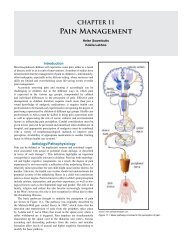

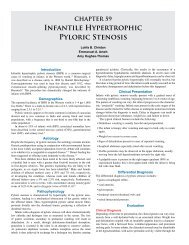
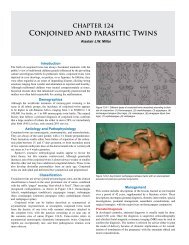
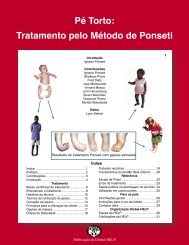
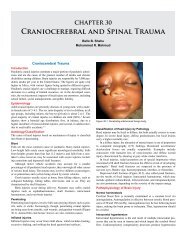

![Steenbeek Brace For Clubfoot [2nd Edition] - Global HELP](https://img.yumpu.com/46612972/1/190x245/steenbeek-brace-for-clubfoot-2nd-edition-global-help.jpg?quality=85)

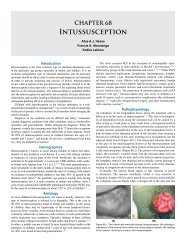

![Basics Of Wound Care [Indonesia] - Global HELP](https://img.yumpu.com/41566370/1/190x245/basics-of-wound-care-indonesia-global-help.jpg?quality=85)
